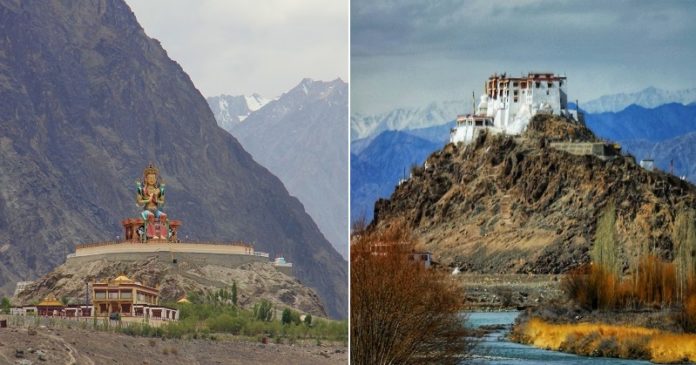
When you read the word ‘monastery’, what comes to your mind? A Buddhist temple located in the far flung and less-explored areas of the Grand Himalayas? Or monks dressed in Buddhist attires chanting mantras? Or the mask-dances with celebrations? Or a place that is peaceful and tranquil? Monasteries have so much more to them than just these perceptions. They have a certain history and culture that they nonchalantly boast of. As we all know, monasteries are buildings or building complexes containing domestic quarters and workplaces of monks, monastics or nuns, living alone or in communities. They also contain a place for worship/prayers like a chapel, church or a temple along with dormitory, cloister, refrectory, library, balneary and infirmary. Some monasteries may also include a hospice, school, barn and in some countries, even a brewery! The Himalayas are known for their monasteries, sitting sturdily atop jagged hills and withstanding years of boorish weather. While they look rustic, they are astonishingly rich in culture and heritage.
We take you through a virtual tour of some of the most popular monasteries located in Leh Ladakh, Jammu and Kashmir.
ADVERTISEMENT
1. Lamayuru Monastery
This Tibetan Buddhist Monastery in village Lamayuru, which lies between Kargil and Leh, is situated at a height of 3,510 metres. This monastery is one of the largest and oldest gompas in Ladakh, with a population of around 150 monk residents. Many years ago, this monastery was a complex comprising of 5 huge buildings, out of which only one remains. It plays host to two annual masked dance festivals, when all the monks of the surrounding areas gather to pray together. The monastery is home to many beautiful wall paintings, murals, thangkas and scriptures. The tourists are allowed to access the prayer hall only, which is one of the most crucial areas of the monastery.
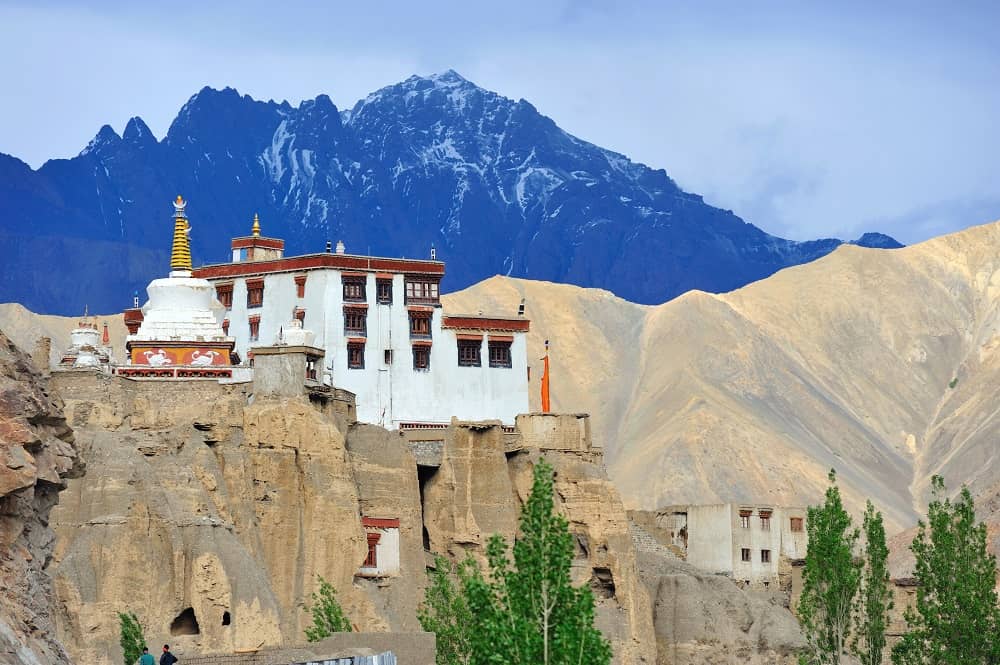
How to get there- Lamayuru village is around 125 kms from Leh on the Leh-Srinagar Highway. You could also take the State Transport Buses which ply between Leh and Lamayuru at 0800 and 1400 hours.
While here- Do not forget to stroll through the Lamayuru village, sipping a cup of tea and enjoying the hospitality of the warm friendly villagers. You could also witness the splendid landscape of Moonland, which is believed to bear a soil similar to the one on moon. You could gorge on Thupkas and biryanis at the Lamayuru Restaurant if hungry!
Stay at- Tharpaling Guest House, Singay Guest House.
ADVERTISEMENT
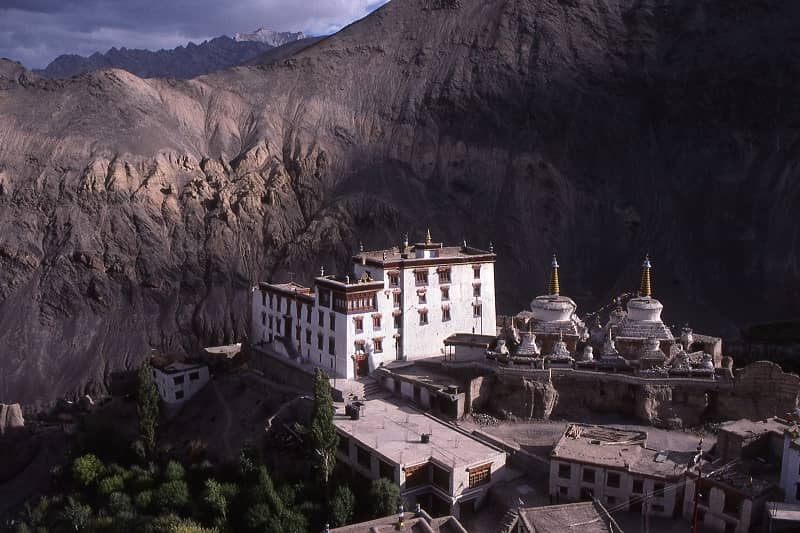
2. Alchi Monastery
Alchi monastery is primarily a monastic complex comprising of four seperate settlements in the Alchi village, dated to different periods believed to be between 958 and 1055 by Rinchen Zangpo . The monastery complex comprises of Dukhang (Assembly Hall), the Sumtsek and the Manjushri Temple along with the ‘Lotsabha Lakhang’ and ‘Lakhang Soma’, which are the lesser known temples. While Dukhang is the largest and oldest preserved part of the monastery, Sumtsek is a 3-story temple popular for its four armed big Bodhisattva statue, equivalent to two floors. The unique style and workmanship of the Alchi monastic complex is the best known in this region which carries the artistic and spiritual details of both Buddhism and Hindu kings of that era in Kashmir and Himachal Pradesh. This complex is home to some of the oldest surviving paintings in Ladakh, huge statues of Buddha, elaborate wood carvings and art work comparable to the Baroque style.
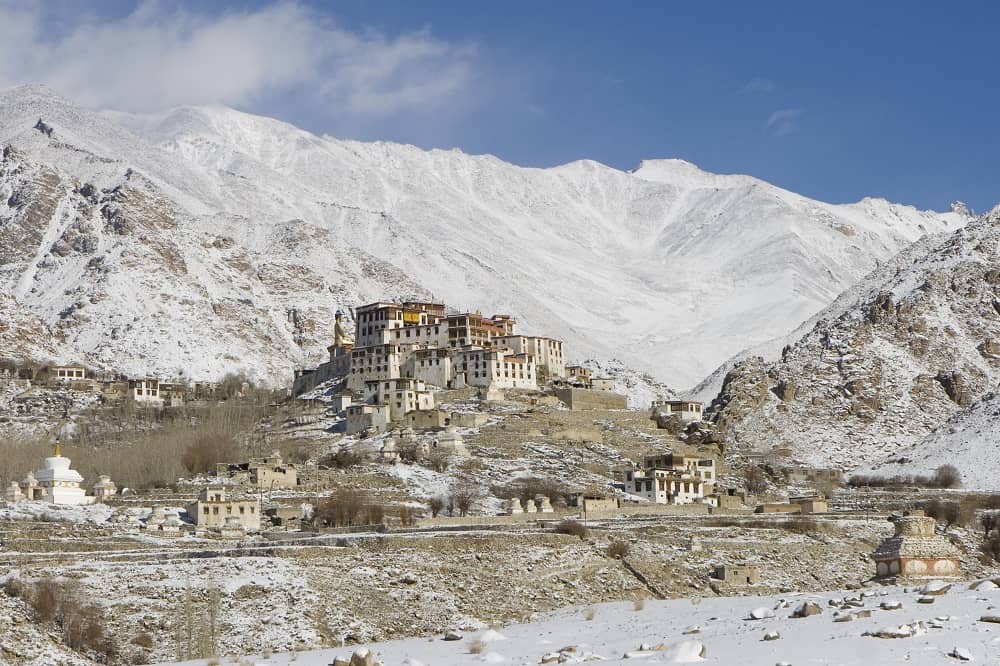
How to get there- The monastery lies around 70 kms from Leh. You could take a cab to reach here.
While here- You can indulge in rafting as this monastery is close to river Zanskar or shop for pashmina shawls, woollen jackets or apricots. You could also taste the Change beer which is a local brew and is widely banned in Leh.
Best time to visit- The most preferrable time to visit the Alchi Gompa is during the festivals of Chotrul Duchen, Dajyur, Galdan Namchot, Losar, Monlam and Sho Dun. Also, the visiting hours are 0800- 1300 hrs and 1330-1800 hrs.
Stay at- Lotsava Guesthouse.
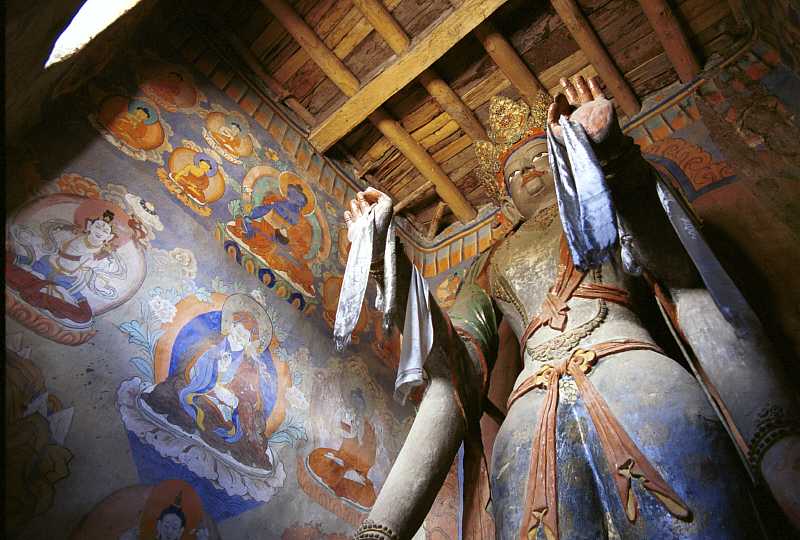
3. Shey Monastery
Situated around 15 kms from Leh, this monastery was built in 1655 by the king of Ladakh, Deldan Namgyal to be used as summer retreat by the kings of Ladakh. The Shey Monastery, built on an altitude of 11,200 feet is known for its giant copper with guilded gold statue of a seated Shakyamuni Buddha and is said to be the second largest such statue in Ladakh. There are many Chortens around here which contain the ashes of royal dignitaries and Lamas.
ADVERTISEMENT
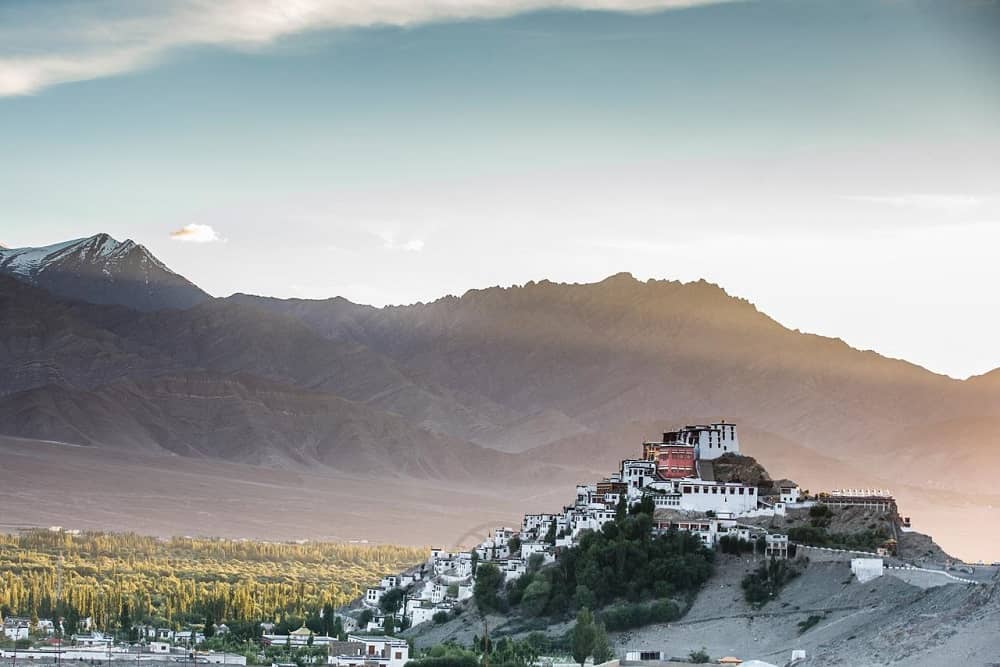
Best time to visit- During the celebrations of Shey Doo Lhoo, which takes place on the 26th and 27th day of the first Tibetan month to celebrate the beginning of sowing season and and Shey Suey Rupla, which is held to welcome the harvesting season.
How to get there- You could hire a cab from Leh to reach this place.
Stay at– Botho Guesthouse and Hotel Whispering Willows.
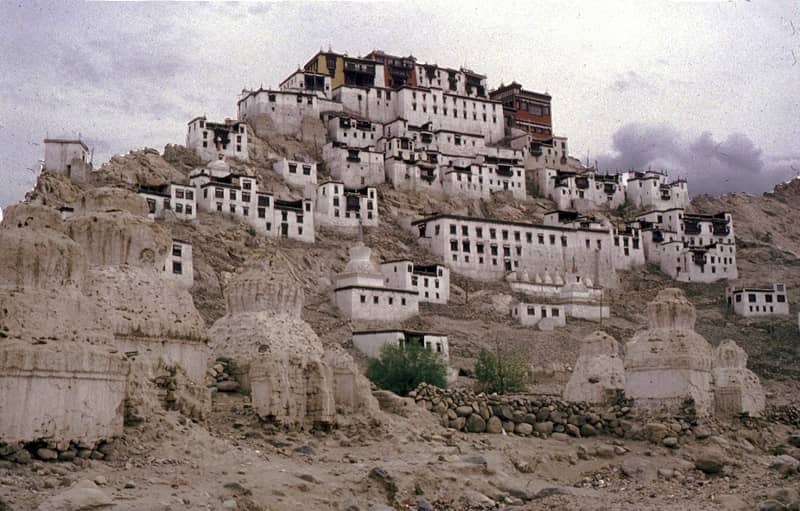
4. Diskit Monastery
This 350 year old monastery is the oldest and largest monastery in the Nubra Valley of Ladakh and belongs to the Gelupa sect of Tibetan Buddhism. Diskit Monastery is situated on a hill, just above the flood plains of the Shyok river and makes for a beautiful sight. The monastery houses a statue of Cho Rinpoche (Crowned Buddha) in the prayer hall, a huge drum and several images of fierce guardian deities. The Diskit Monastery also runs an NGO, Tibet Support Group. One of the most spectacular feature of this monastery is the panoramic view of the Nubra valley from the top of the monastery.
ADVERTISEMENT
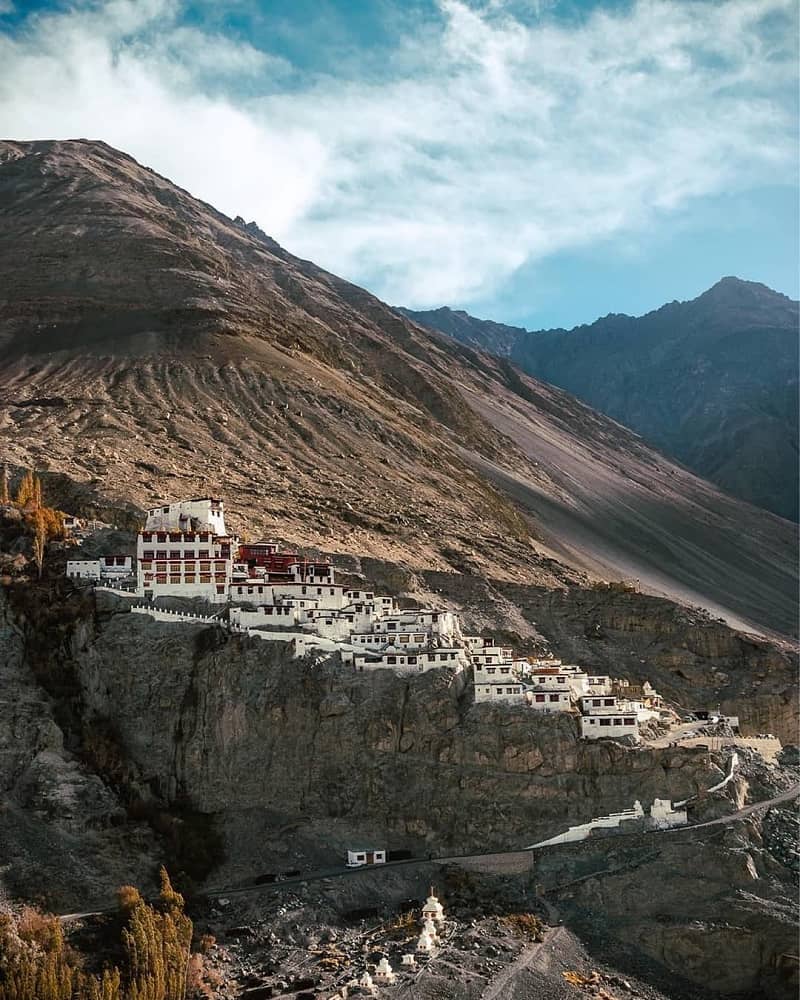
How to get there- You can take a cab from Leh to reach the Diskit village.
While here- Do not forget to see the 106 feet long statue of Jampa ( Maitreya) Buddham, built atop a hill, facing the river Shyok.
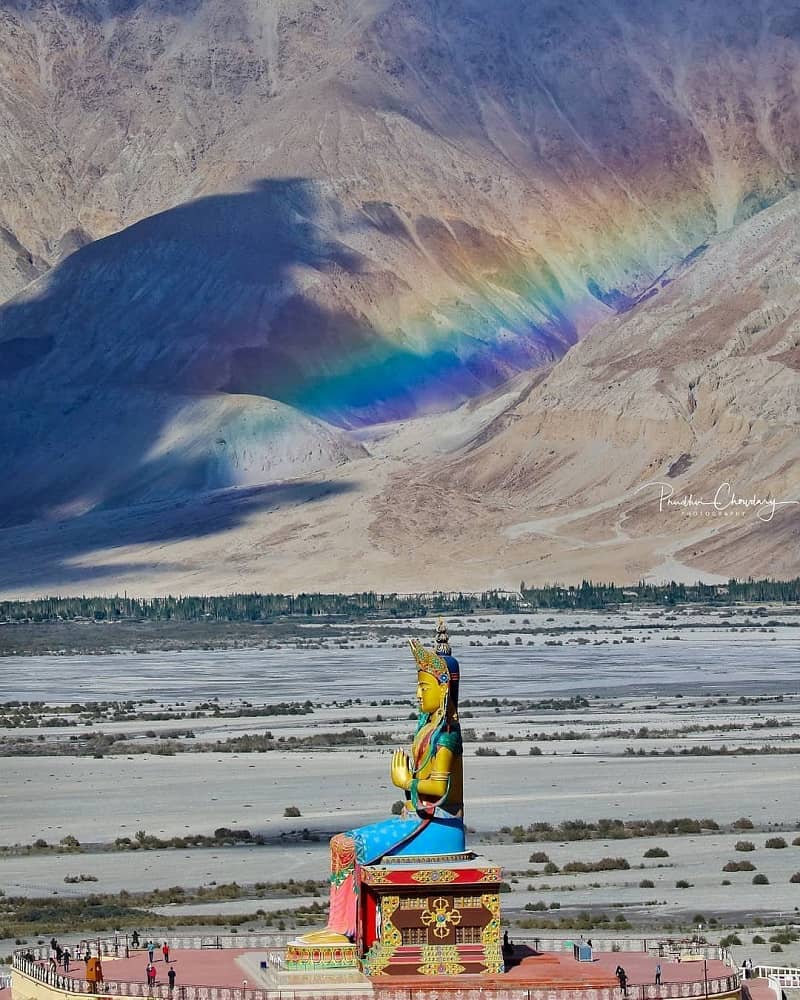
5. Spituk Gompa
Situated atop a hill at a height of 3,307 metres, this monastery lies around 8kms from Leh. The site of this monastery was blessed by the Arhat Nyimagung and dates back to the 11th century. The monastery comprises of three chapels, many statues of Buddha and thangkas, with the Dukhang Hall being the main highlight. The monastery houses about 100 monks and contains a giant statue of Kali. This monastery is home to the Gustor Festival which is held from the 27th – 29th day in the eleventh month of the Tibetan calendar. This festival wtiness a lot of mask-dances and prayers with a large number of natives getting together.
While here – enjoy the artifacts and unique collection of ancient masks, antique arms and fine thangkas along with the statue of Vajrabhairava in the upper section; however, it is only unveiled during the festivals.
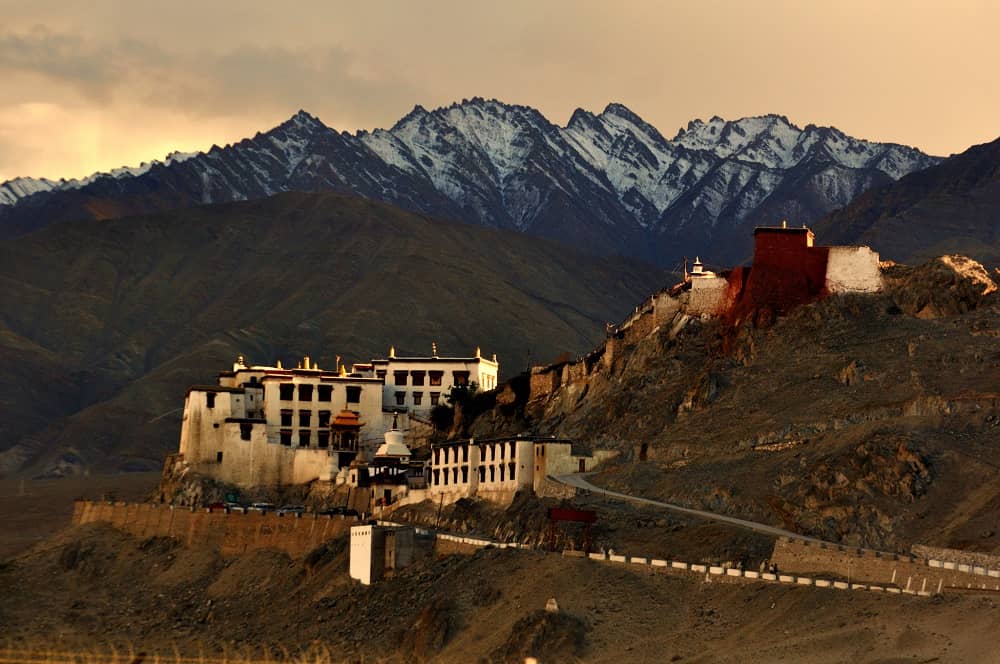
How to get there- You can take a cab from Leh to reach this monastery.
ADVERTISEMENT
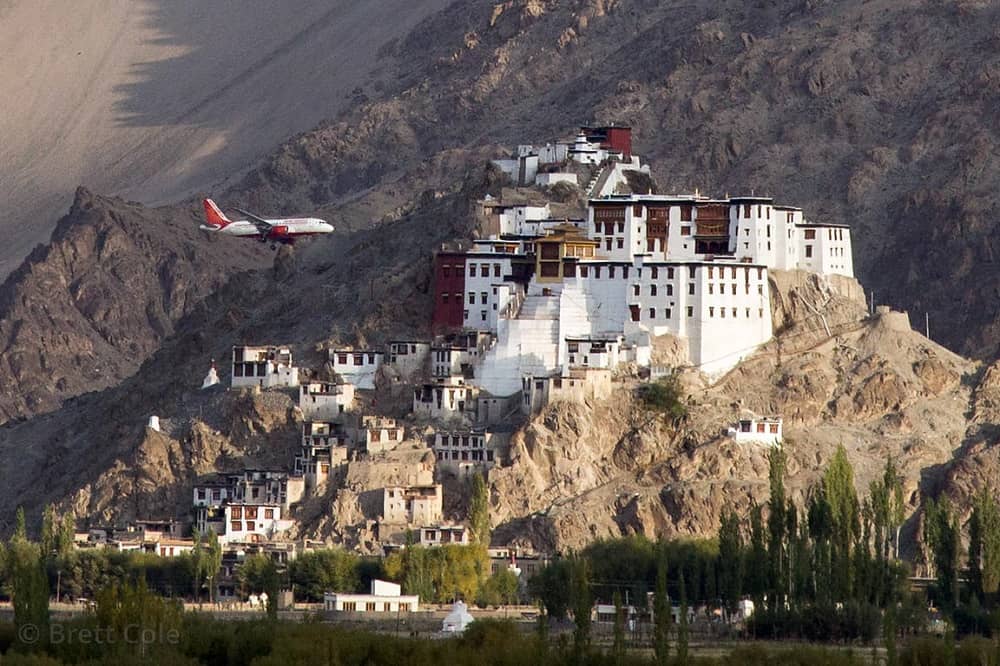
6. Namgyal Tsemo Monastery
This is another Buddhist monastery in the Leh district of Ladakh and worth paying a visit to. This monastery comprises of a three-storey high gold statue of Maitreya Buddha along with many ancient manuscripts and frescoes. It was founded by King Tashi Namgyal of Ladakh in 1430. This monastery is situated atop a mountain just behind the Leh Palace and offers panoramic views of the snow clad mountains of the Zanskar range, Indus river and the surrounding areas of the valley. This monastery is a known for being a ‘photographer’s delight’ as the view changes with the light throughout the day.
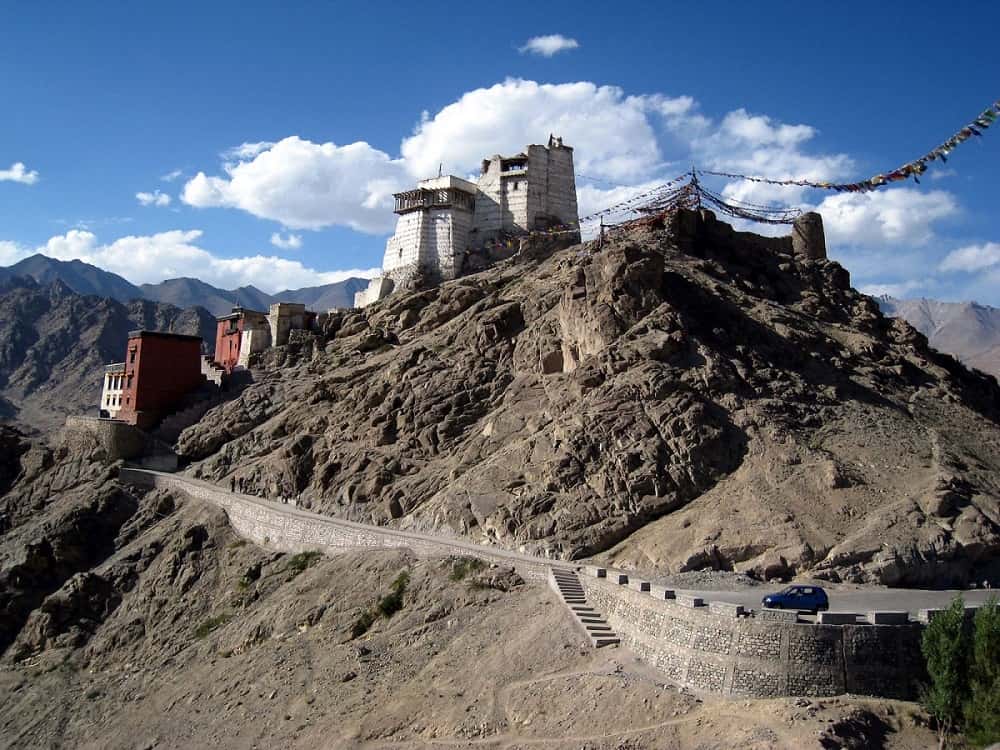
How to get there- You could take a cab to this monastery from anywhere in Leh.
While here- You can visit the Namgyal Tsemo Palace which is 9 stories high and offers a breathtaking view of the entire region.
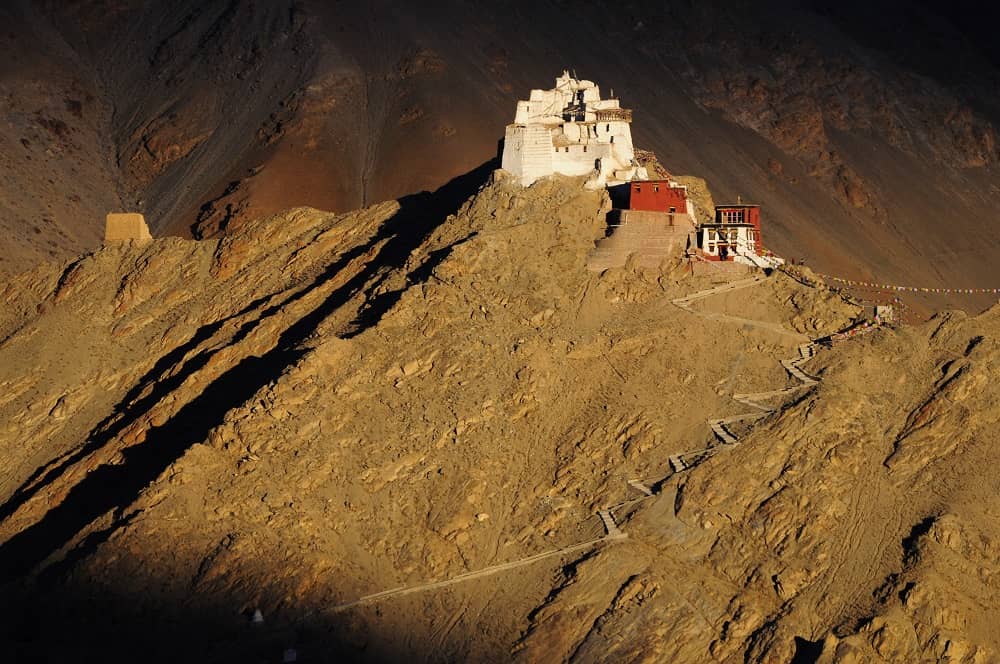
7. Hemis Monastery
This monastery is a Himalayan Buddhist monastery of the Drukpa Lineage in Hemis, Ladakh. The monastery is located around 45 kms from Leh and hosts the Annual Hemis Festival in early June. The monastery is believed to have existed before the 11th century, however it was re-established/completed in 1672. This monastery is believed to be the place where young lamas are trained for the royal monasteries at Leh, Shey and Basgo. Hemis monastery houses many beautiful thangkas along with many gold statues and stupas which are decorated with precious stones. This monastery is considered to be the most beautiful and most important of all monasteries in the Ladakh region and the annual festival which held here during the months of June and/or July is one of the major tourist attractions.
ADVERTISEMENT
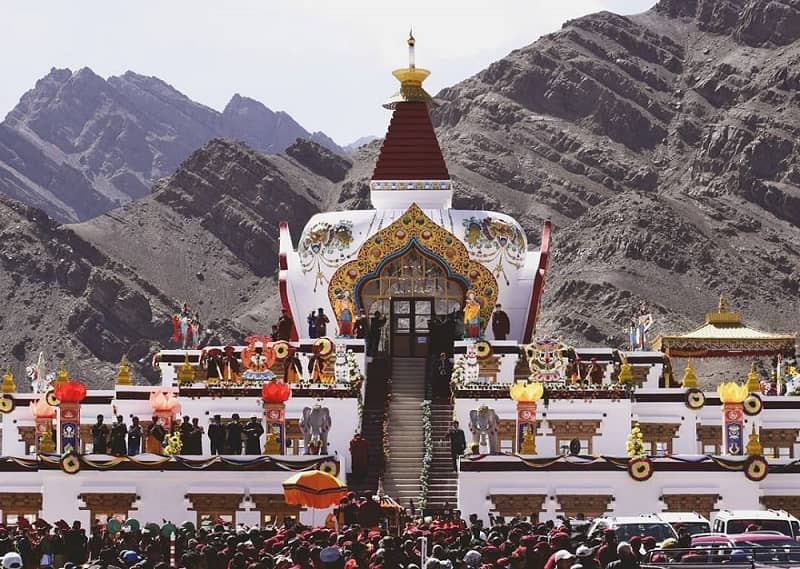
How to get there- This monastery can be reach by cab from anywhere in Leh.
While here- Do not forget to explore a museum which exhibits a large collection of Buddhist relics and to pay homage to the large statues of Lord Buddha and Guru Rimpoche.
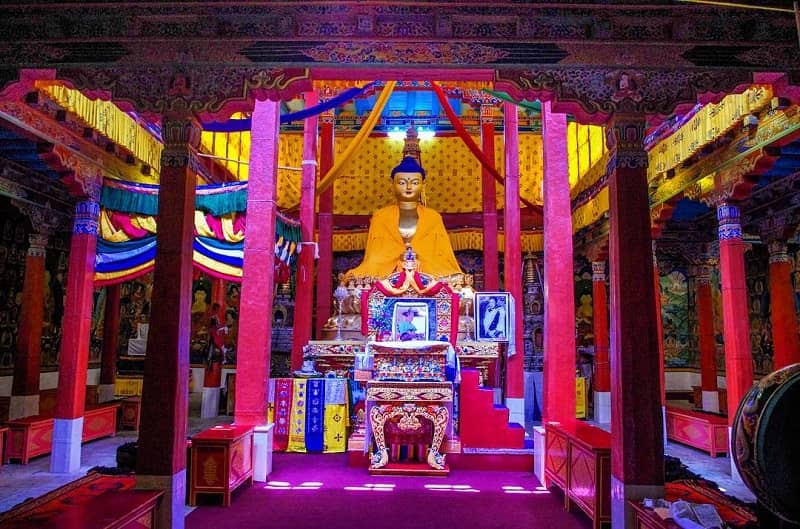
8. Thiksey Monastery
This monastery is a gompa affiliated with the Gelug sect of Tibetan Buddhism and is located atop a hill at a height of 3,600 m, around 19 kms from Leh. It is the largest gompa in central Ladakh and is known for its resemblance to the Potala Palace in Lhasa, Tibet. This twelve story complex contains a separate set of buildings for female renunciates and houses many items of the Buddhist art such as stupas, thangkas, wall paintings and swords. Not to be missed is the 49 feet high statue of Maitreya, which was installed to commemorate the visit of the 14th Dalai Lama. It is the largest such statue in Ladakh. The monastery is home to a large pillar engraved with Buddha’s teachings along with a 15 metre high statue of Buddha in the main prayer hall.
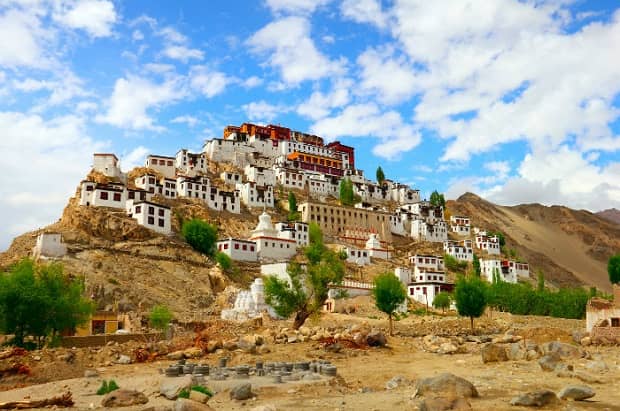
How to get there- This place is well connected to most places arount it through cabs and buses.
ADVERTISEMENT
While here- You can pay a visit to the museum which houses many sacred items.
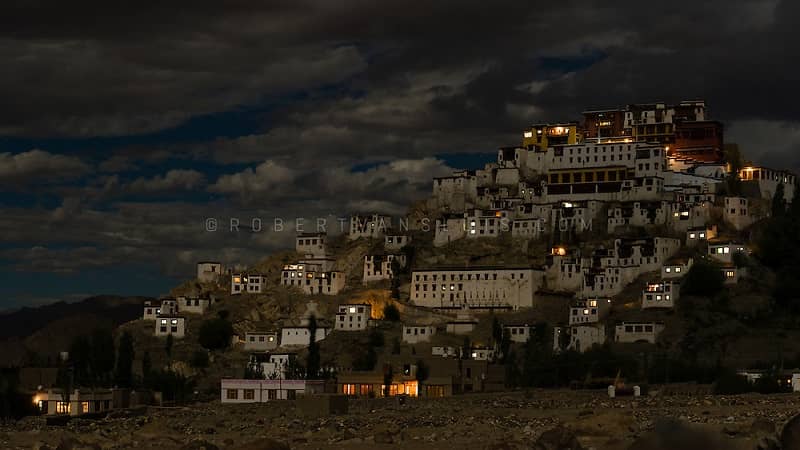
9. Likir Monastery
This gompa is located around 52 kms in the west of Leh and beautifully sits on a little hill in the valley. It is situated near the river Indus on the Srinagar-Leh Highway. Located on an erstwhile major trade route which travelled via Tingmosgang, Hemis, Likir to Leh, this village now stays isolated. Belonging to the Gelugpa sect of Tibetan Buddhism, this monastery was established in 1065 by Lama Duwang Chosje, under the command of the fifth king of Ladakh, Lhachen Gyalpo. The monastery has two assembly halls known as Dukhangs. While the newer Dukhang is around only 200 years old, the older Dukhang is relatively more elaborate as it houses six rows of seats for the lamas and a throne for the Head Lama of Likir, besides containing huge statues of Bodhisattva, Amitabha, Sakyamuni, Maitreya and Tsong Khapa, precious old manuscripts, a remarkable thangka collection, old costumes and earthen pots. The newer Dukhang contains a unique statue of Avalokitesvara with 1000 arms and 11 heads along with bookcases with volumes of Sumbum, describing the life and teachings of Tsong Khapa.
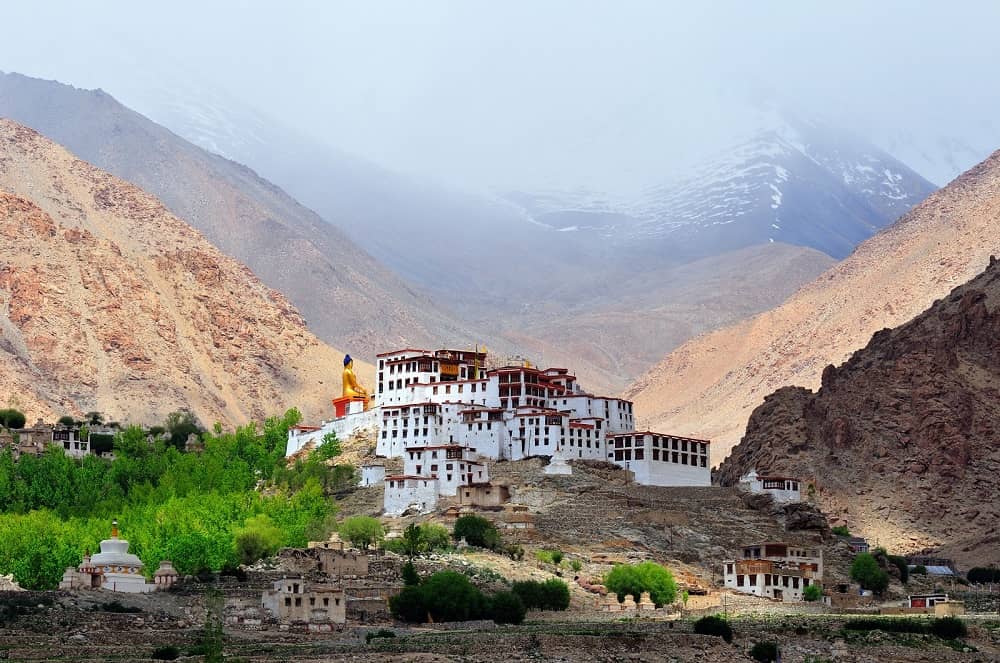
How to get there- You can take a cab from Leh to reach this monastery.
While here- if you are visiting around the 27th-29th in the 12th month of Tibetan calendar, witness the Likir Dosmoche Festival showcasing some exceptional religious dance performances.
ADVERTISEMENT
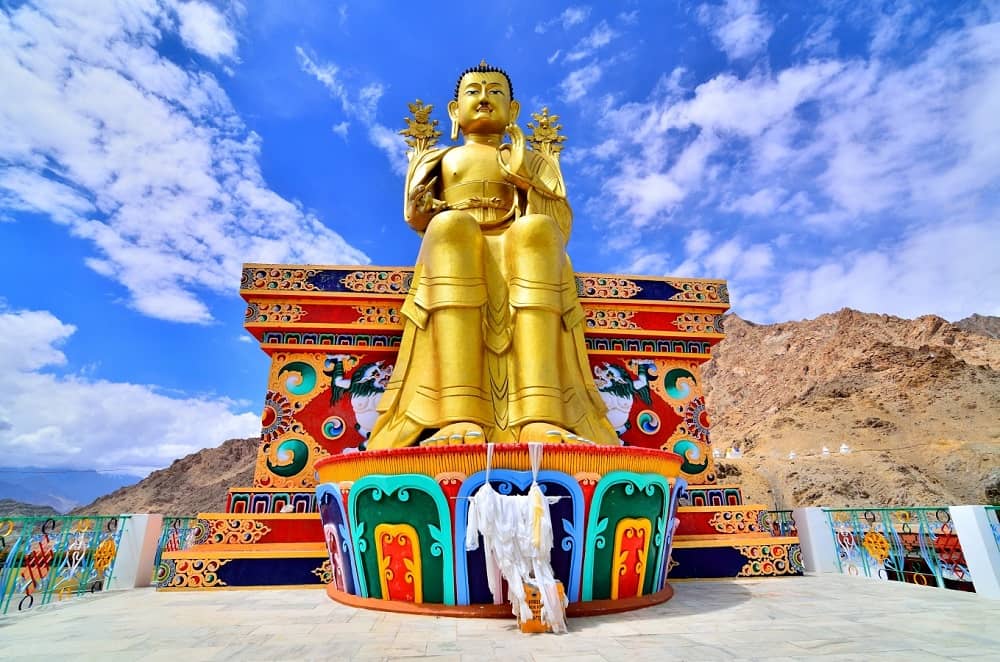
10. Phugtal Monastery
One of the only Buddhist monasteries in Ladakh that can still be reached only by foot, it was built around a natural cave around 2,550 years ago. The cave is believed to have been visited by various sages, scholars, translators and monks in search of peace and solitude for meditation back then. The monastery gets its name from the Zangskari dialect of the Tibetan languages meaning, ‘phuk’ for cave and ‘thal’ for leisure/liberation; referring to the ‘cave of leisure’ or ‘cave of liberation’. It is located in the remote village of Lungnak and getting its supplies via horses/donkeys and mules in the warmer months and through the frozen Zanskar river in winters. This monastery maintains a Traditional Tibetan medical clinic which caters to the local community of the village of Lungnak. An on-site Amchi (a traditional Tibetan physician) provides natural Sowa-Rigpa medicine, mostly prepared at the monastery itself. The monastery is home to various cultural festivals such as Smonlam Chenmo, Chudsum Chodpa, Chonga Chodpa, Gyalwe Jabstan, Yarnas, Gadam Nagchod and Jigched Lhachusum Ceremony.
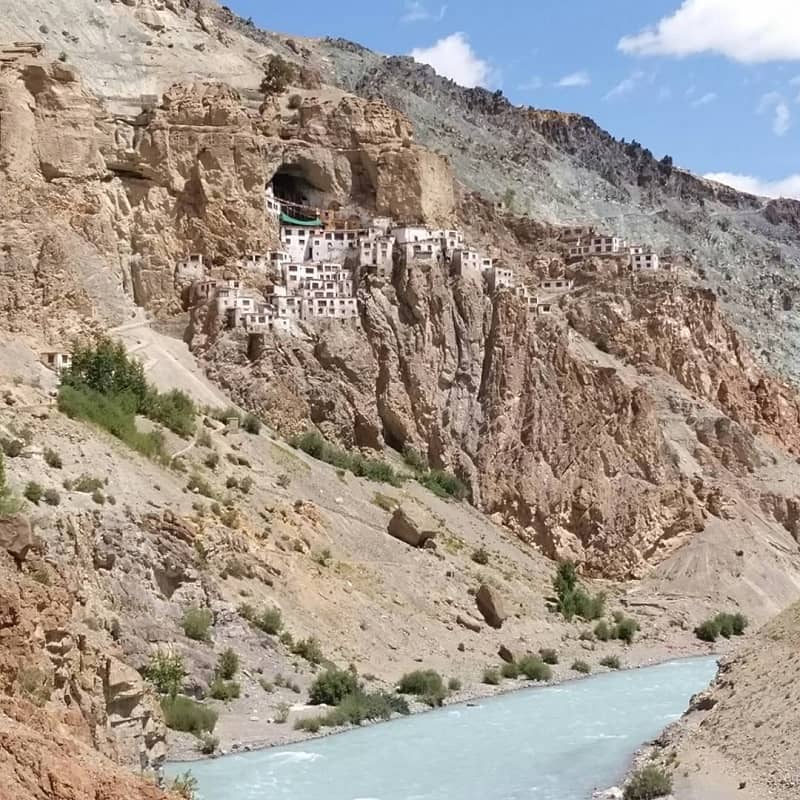
How to get there- As mentioned, this monastery can only be reached by foot, so get ready to do some walking and climbing!
While here- Pay a visit to the adjoining Phuktal Monastic School which offers quality education to the poor and least educated without charging any fees.
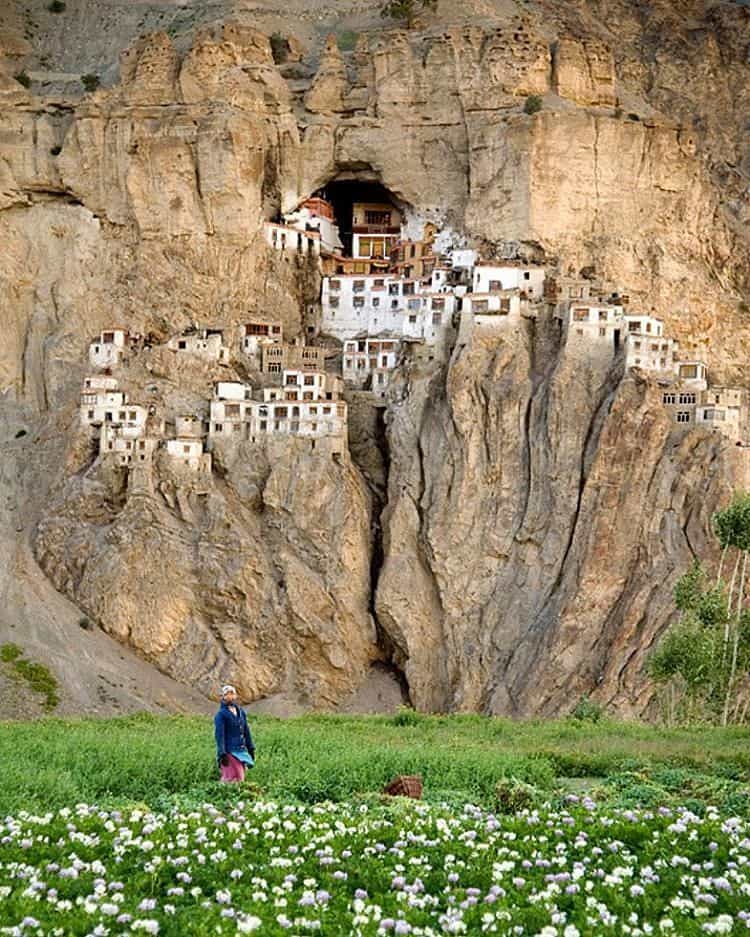
The most recommended time to visit any monastery in the Leh Ladakh region would be during the summer months i.e. between February and October. The winter months witness a lot of snow and one could be left stranded as the roads get blocked/closed. These monasteries are not just places to explore but also a way to escape the busy lives. They not only provide the much needed peace and tranquility, but also lend us a different perspective and better understanding about the Buddhist culture. These are the most popular gompas of the Ladakh region, although you may find many more once you set out to explore. And each gompas tells a story about the place, sect and history of that kingdom. To conclude, I would say, it is an experience worth experiencing!
ADVERTISEMENT
Also read- 11 Monasteries In Lahaul Spiti Where One Can Attain Spiritual Bliss
ADVERTISEMENT











